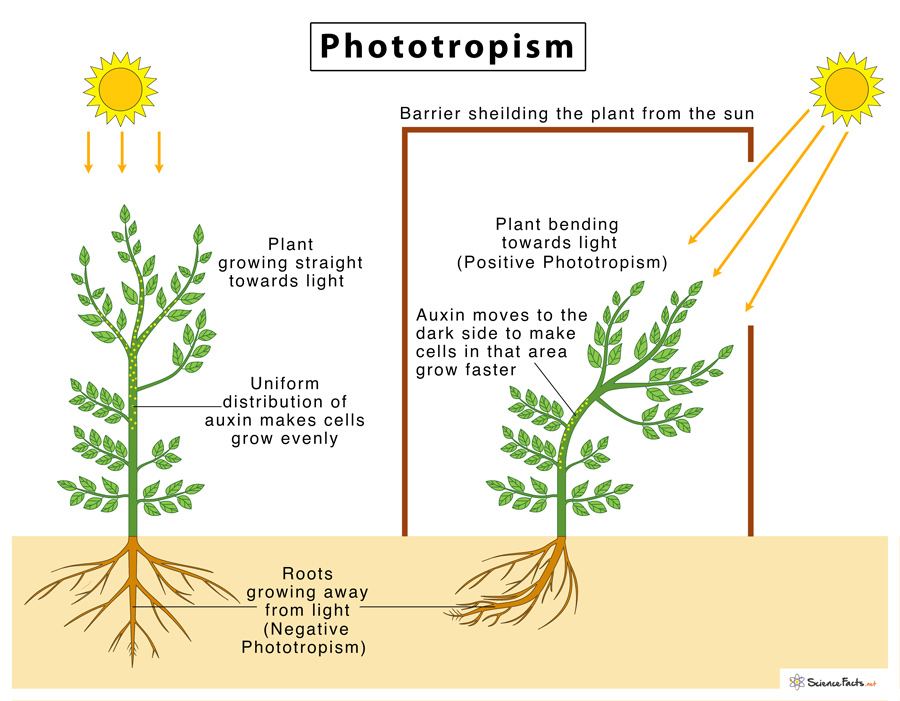Phototropism
What is Phototropism
‘Photo’ means light, and ‘tropism’ means turning. Phototropism is the movement of plants or other organisms, such as fungi, in the direction of light or away from it.
Types of Phototropic Movement
Based on the orientation of a plant or other organisms in response to light, phototropism is of two types:
- Positive phototropism: Growing in the direction of a light source, as found in the plant shoot.
- Negative phototropism (Aphotropism): Growing away from light, as observed in plant roots.
What Causes Phototropism
The presence of light is the most important factor in phototropism. Light energy stimulates the rate of photosynthesis in plants causing food production and generation of energy in the form of high-energy phosphate molecule, ATP. Phototropism is thus a survival strategy adopted by plants to maximize their light-harvesting capacity.
Early Experiments to Explain Phototropism
The Experiment of Charles Darwin
In 1880, Darwin and his son Frances in their experiment described the bending of grass seedlings in the presence of light. They used newly grown plants with their shoot tips covered by a sheath called the coleoptile. Through this experiment, they found that coleoptile-covered plants did not respond to the light stimulus. In separate research involving plants where either the tip or the lower part of the coleoptile is covered, they concluded that the upper part is only capable of sensing the light response.
Peter Boysen-Jensen Experiment
In 1913, Danish physiologist Peter Boysen-Jensen, in a follow-up study to Darwin, showed that a chemical signal produced at the tip of the shoot in plants is responsible for the bending response of the coleoptiles in response to light.
In his experiment, he removed the tip of the coleoptile and covered the cut portion with gelatin and then reinserted the tip. To his observation, he found the coleoptile to bend towards the light. On repeating the experiment using mica in place of gelatin, he discovered that the coleoptile lost its bending response. This result proved that gelatin having pore allowed a specific chemical signal to communicate between the tip and the base of the plant while mica being impermeable prevented any such communication.
In another experiment, Boysen-Jensen further showed that the chemical signal travels only through the coleoptile-covered plant’s shaded side. This proved that the signal is a growth stimulator.
Kenneth Thimann Experiment
Later in 1933, Kenneth Thimann isolated and identified the chemical signal responsible for plant growth and movement as indole-3-acetic acid or auxin.
Physical Basis of the Phototropic Response
Plants sense light using specialized regions called photoreceptors. Photoreceptors are made of pigment molecules called chromophores that are responsible for absorbing light energy. On absorbing light, the chromophore initiates a signaling pathway that ultimately causes the plant to bend towards or away from the light source.
How Does Auxin Promote Phototropism
Auxin is the growth hormone produced at the tip of plants. The mechanism showing the role of auxin in phototropic response is described in the following steps:
- The specific blue-light receptor proteins called phototropins receive the light of wavelength around 450 nanometers and get stimulated to activate several hormones, including the growth hormone, auxin.
- The phototropin molecules on the bright side absorb lots of light, while molecules on the shady side absorb much less. This causes more auxin to be transported down the shady side, and less to be transported down the bright side.
- Auxin stimulates a decrease in cell-pH, which helps to activate a group of enzymes responsible for cell growth and elongation in the shaded regions, causing the stem to bend towards the light source.
Examples
Positive Phototropism
- Sunflower plants (Helianthus annus): Highly phototrophic. They grow towards the sun, but they can also be seen to follow the sun’s movement from east to west. Sunflower plants need more light for growth and survival, as well as for fruiting and flowering, compared to other flowering plants.
- Seedlings: Grow vertically upwards when the amount of light is the same on all sides. However, when the light is not evenly distributed, the seedling tends to bend in the direction of light.
- Fungi (Genus Pilobolus): Feed and survive on dead and decaying matter. Pilobolus crystallinus (commonly known as the ‘hat-thrower fungus’) uses phototropism to disperse their spores in the vegetation where herbivores consume them.
Negative Phototropism
- The plant roots growing downwards and away from the light source shows negative phototropism
Benefits
- Promotes food production in plants by photosynthesis
- Helps in growth of the plant
- Helps fungi such as Pilobolus crystallinus to complete their lifecycle
-
References
Article was last reviewed on Thursday, February 2, 2023




